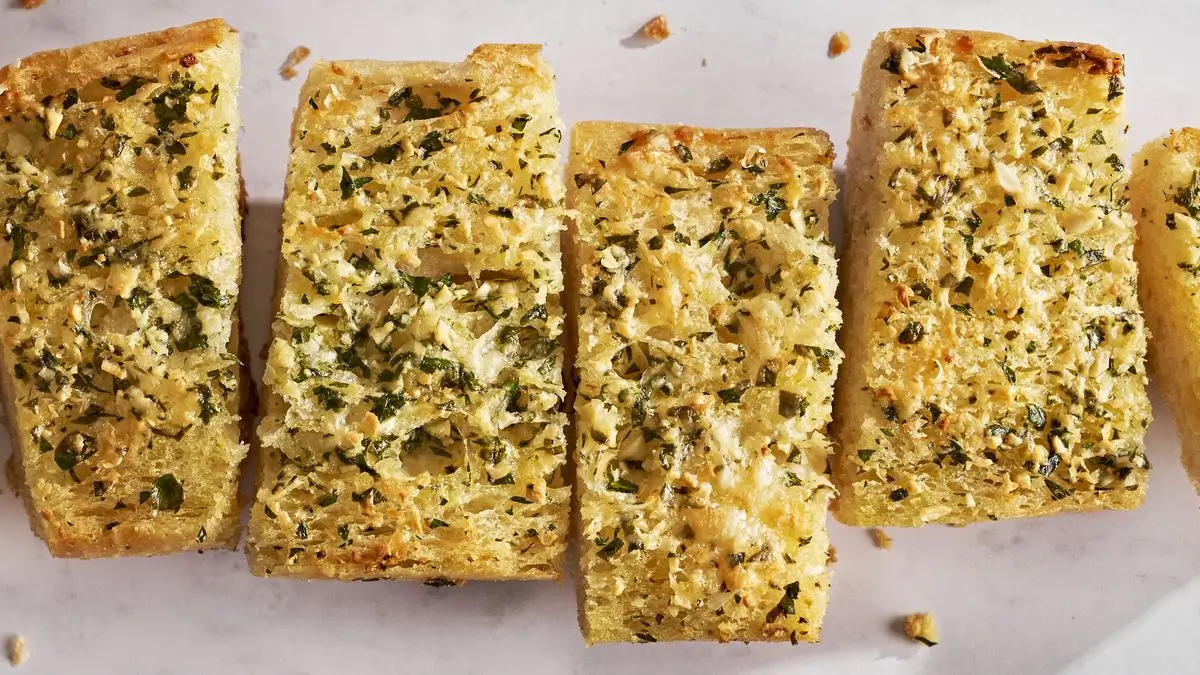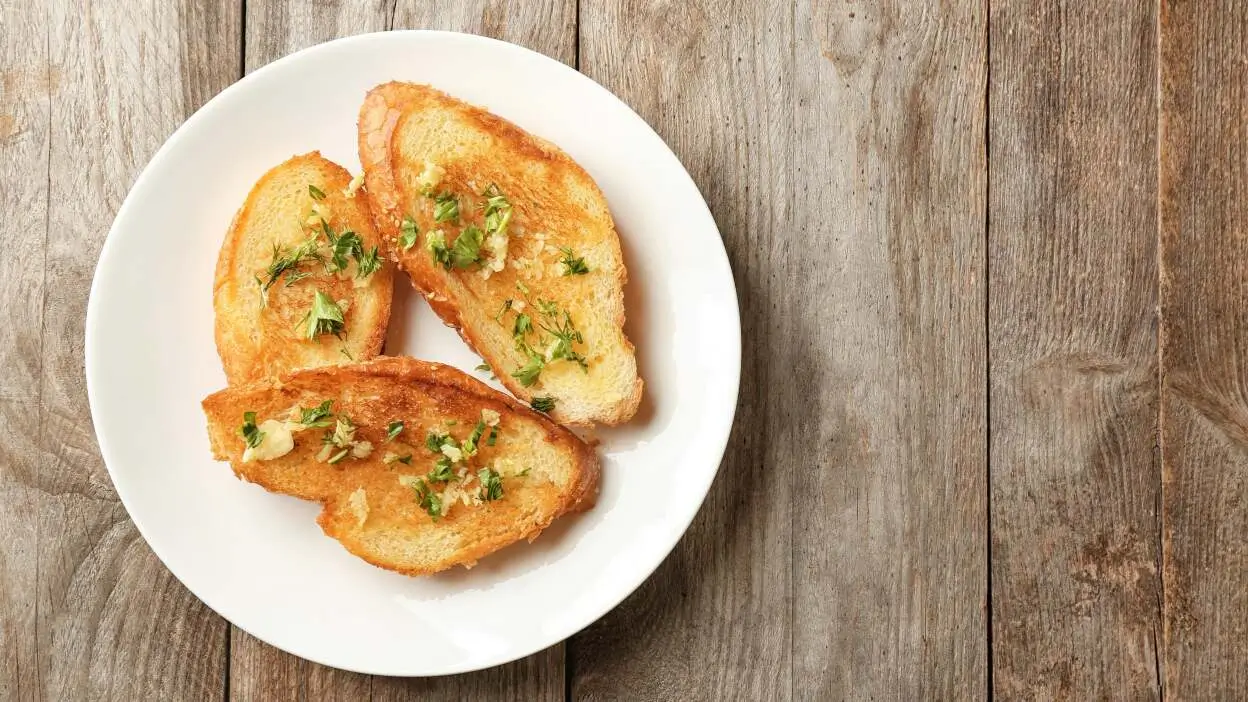Garlic bread is a beloved side dish that graces many dinner tables worldwide.
Its aromatic blend of garlic, butter, and bread is a comforting indulgence that tantalizes our taste buds. But beyond its delectable flavor, is garlic bread good for you?
In this article, we’ll explore the potential health benefits and drawbacks of this popular food, helping you make an informed decision about incorporating it into your diet.
Garlic bread itself isn’t a healthy food. It’s typically high in calories, fat, and refined carbs. However, the garlic in it offers potential heart health and immune system benefits.
Moderation is key. Enjoy a small portion occasionally, or opt for healthier alternatives like whole-wheat bread and olive oil for a more balanced treat.
The Nutritional Value of Garlic Bread
To understand whether garlic bread is good for you, let’s first examine its nutritional profile.

While the specific ingredients and preparation methods can vary, a typical serving of garlic bread contains:
- Carbohydrates: Garlic bread is primarily made from refined wheat flour, providing a source of carbohydrates. However, these are often simple carbs with minimal fiber.
- Fats: The butter or olive oil used in garlic bread provides a significant amount of fat, which can be a concern for those watching their calorie and fat intake.
- Protein: Garlic bread is generally low in protein, as bread itself is not a significant source of this nutrient.
- Garlic: The star ingredient, garlic, is rich in beneficial compounds like allicin, which has antimicrobial and anti-inflammatory properties.
The Potential Health Benefits of Garlic Bread
While garlic bread may not be considered a healthy food, it does offer some potential benefits when consumed in moderation.
Heart Health
Garlic, a key ingredient in garlic bread, has been associated with potential benefits for heart health.
Several studies suggest that garlic may help lower cholesterol levels and blood pressure, reducing the risk of heart disease.
However, it’s important to note that these benefits are primarily associated with raw or lightly cooked garlic, as the allicin content can diminish during prolonged cooking or baking.

Antimicrobial Properties
Garlic contains compounds like allicin that have antimicrobial properties. These compounds may help fight off certain bacteria, fungi, and viruses, potentially boosting the immune system.
Again, the extent of these benefits in garlic bread may depend on how much raw garlic is used and how it’s prepared.
Anti-inflammatory Effects
Some research suggests that garlic may have anti-inflammatory effects on the body.
Chronic inflammation is linked to various health conditions, including heart disease, cancer, and autoimmune disorders.
By potentially reducing inflammation, garlic bread (in moderation) may offer some protective benefits.
The Potential Drawbacks of Garlic Bread
While garlic bread has some potential benefits, it’s important to consider the drawbacks as well.
High in Calories and Fats
Garlic bread is typically high in calories and fats, particularly if made with butter or other animal-based fats.
Consuming large portions or frequent servings can contribute to weight gain and potentially increase the risk of obesity-related health issues.

Refined Carbohydrates
Most garlic bread is made with refined wheat flour, which provides simple carbohydrates with minimal fiber.
Consuming too many refined carbs can lead to blood sugar spikes and may increase the risk of insulin resistance and type 2 diabetes.
Potential for Allergies and Intolerances
For individuals with gluten intolerance or wheat allergies, garlic bread made from traditional wheat flour may not be suitable.
Additionally, some people may experience digestive issues or discomfort from the high-fat content in garlic bread.
Is Garlic Bread Good for You?
Like many foods, the key to enjoying garlic bread while minimizing potential drawbacks lies in moderation.
Occasional indulgence in small portions is unlikely to cause significant harm for most individuals.
However, if you have specific dietary concerns or health conditions, it’s always best to consult with a healthcare professional or a registered dietitian for personalized advice.

Healthy Alternatives and Tips
If you’re looking to incorporate the flavors of garlic bread into your diet while minimizing the potential drawbacks consider these healthier alternatives and tips:
- Whole Grain Garlic Bread: Opt for whole grain bread instead of refined flour options. Whole grains provide more fiber, nutrients, and a lower glycemic impact, making them a healthier choice.
- Homemade Garlic Bread: Making your garlic bread at home allows you to control the ingredients and portion sizes. Use healthy fats like olive oil or avocado oil instead of butter, and incorporate fresh garlic for maximum health benefits.
- Garlic Bread Croutons or Topping: If you’re watching your carb or calorie intake, consider using garlic bread as a topping or crouton on salads or soups instead of consuming an entire portion.
- Roasted Garlic Alternatives: Roasted garlic cloves or garlic-infused oils can provide a similar flavor profile to garlic bread while offering more versatility in incorporating garlic into various dishes.
Are Clover Sprouts Good for You?
Conclusion
Garlic bread is undoubtedly a delicious treat, but its health benefits and drawbacks depend on several factors, including portion size, ingredients, and individual dietary needs.
While it may not be considered a healthy food, garlic bread can be enjoyed in moderation as part of a balanced diet, particularly if you opt for healthier alternatives or make adjustments to the traditional recipe.
Ultimately, moderation and mindful consumption are key when indulging in this flavorful side dish.
References & Resources
- https://www.healthline.com/nutrition/11-proven-health-benefits-of-garlic
- https://connect.mayoclinic.org/blog/take-charge-healthy-aging/newsfeed-post/make-the-switch-to-whole-grains/
- https://www.heart.org/en/healthy-living/healthy-eating/eat-smart/nutrition-basics/carbohydrates
- https://www.myfitnesspal.com/nutrition-facts-calories/toast-bread

